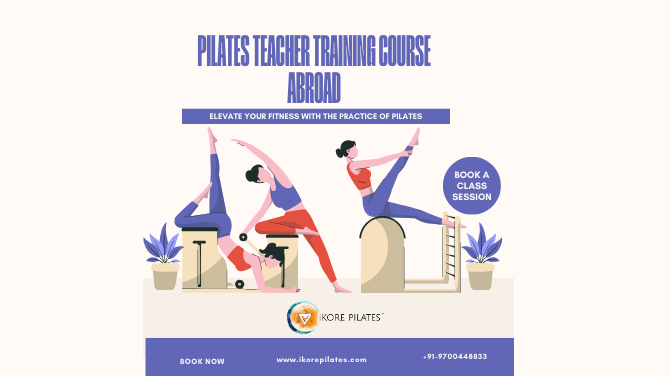Pursuing a Pilates teacher training course abroad can be an enriching experience, offering access to diverse teaching methodologies, exposure to international fitness standards, and the opportunity to immerse oneself in a new culture. For those passionate about Pilates and aiming to become certified instructors, studying abroad opens doors to broader perspectives and advanced learning opportunities. This comprehensive guide outlines key considerations and steps to successfully undertake a Pilates teacher training course in a foreign country.
1. Understand the Benefits of Training Abroad
Choosing to complete your Pilates teacher training course abroad offers several advantages. International programs often provide exposure to renowned instructors and unique teaching styles not commonly found locally. Studying in a different cultural setting can also broaden your understanding of global fitness trends and client needs.
Additionally, training abroad can enhance your professional credibility, making you a more attractive candidate to potential employers. The opportunity to network with instructors and peers worldwide can lead to valuable collaborations and career opportunities in the future.
2. Research Accreditation and Course Content
When selecting a Pilates teacher training course, ensure that the program is accredited by a recognized Pilates organization. Accredited programs adhere to industry standards, ensuring that you receive comprehensive training in essential areas such as anatomy, physiology, and teaching techniques.
Review the course curriculum to ensure it aligns with your career goals. Some programs focus on mat-based Pilates, while others emphasize equipment-based training. Confirm whether the course includes practical teaching hours, which are crucial for gaining hands-on experience.
3. Choose the Right Destination
Selecting the ideal destination for your training is crucial. Consider countries known for their reputable Pilates training programs and vibrant fitness communities. Research visa requirements, cost of living, language barriers, and cultural aspects that may impact your experience.
Destinations with a strong wellness culture can provide additional learning opportunities, such as workshops on mindfulness, nutrition, and holistic health practices. Choosing a location that aligns with your personal and professional preferences will enrich your overall training experience.
4. Plan Your Budget
Training abroad involves several costs beyond tuition fees, including travel expenses, accommodation, meals, and study materials. Create a detailed budget that accounts for these expenses and explore available scholarships or payment plans offered by training providers.
Consider cost-effective accommodation options, such as shared housing or student residences. Budgeting for cultural experiences and leisure activities will also help you make the most of your time abroad without financial stress.
5. Assess Language Requirements
Language proficiency can significantly affect your learning experience. Ensure that the training program is conducted in a language you are fluent in or comfortable with. Some programs offer language support or translation services to assist international students.
If the course is conducted in a foreign language, consider taking language classes beforehand to improve your comprehension and communication skills. Understanding the local language will also enhance your overall experience, enabling you to connect better with peers and the community.
6. Prepare for Cultural Immersion
Living and studying in a foreign country involves adapting to new cultural norms and practices. Embrace cultural immersion by learning about local customs, traditions, and etiquette. Respecting cultural differences fosters positive relationships and enriches your overall experience.
Participate in community events and explore the local lifestyle to gain a deeper appreciation of your host country. Cultural adaptability will not only enhance your personal growth but also develop your interpersonal skills—valuable traits for a successful Pilates instructor.
7. Evaluate Post-Training Opportunities
Consider the career prospects available after completing your training abroad. Some countries offer post-study work visas that allow you to gain professional experience locally. Research potential employers, fitness centers, or wellness studios that value internationally trained instructors.
Additionally, evaluate how your international certification is recognized in your home country or other regions where you intend to work. Certifications from accredited programs typically have global recognition, enhancing your employability and career growth prospects.
8. Network and Build Professional Relationships
Building a strong professional network during your training can open doors to future opportunities. Engage actively with instructors, peers, and fitness professionals you meet during the course. Participate in seminars, workshops, and industry events to expand your connections.
Maintaining relationships with your international network can provide valuable insights, job opportunities, and support throughout your Pilates career. Joining global Pilates associations can also help you stay updated on industry trends and professional development opportunities.
9. Stay Committed to Continuous Learning
Completing a Pilates teacher training course abroad is just the beginning of your teaching journey. The Pilates industry continuously evolves, and staying updated on new techniques, research, and best practices is essential.
Pursue advanced certifications, attend workshops, and engage in self-study to deepen your expertise. Continuous professional development ensures that you provide high-quality instruction and remain competitive in the global fitness industry.
Conclusion
Enrolling in a Pilates teacher training course abroad is a transformative step towards becoming a skilled and knowledgeable instructor. By choosing an accredited program, planning your budget, embracing cultural experiences, and building a strong professional network, you can unlock a wealth of opportunities and set the foundation for a successful international Pilates career. With careful planning and dedication, your training abroad can be a rewarding journey that shapes both your professional path and personal growth.









